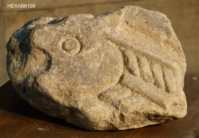
 Hover on
Hover onThumbnail
to
enlarge
This stone from Wilfrid's church resembles work from Poitiers, France, which in the 7th century was part of Gaul. Wilfrid was heavily influenced by the church decoration he saw in Gaul and Italy.
Pre-October 2014 in Recess 5 of nave N wall; previously in south aisle of chancel [CASSS 1977]
2012: “Three important decorative pieces of cattle and fish, unique in England, which need to be properly secured (which they are not currently). These pieces tell an important story of Wilfrid's continental tastes and thus his theology of a universal catholic church.” [Hexham Abbey collection faculty document.pdf, §9]